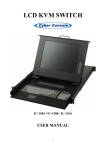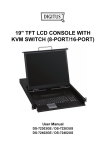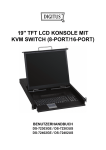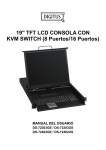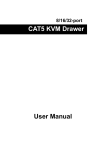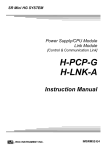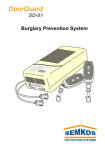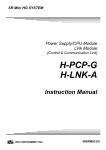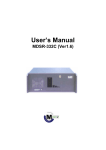Download Richard Gray Power Company MX81-IP KVM switch
Transcript
Combo-Free KVM Switch USER’S MANUAL -1- GENERAL INTRODUCTION The KVM Switch allows you to control several sets of personal computers by keyboard, mouse and monitor. In the meantime, you just need to connect the cable and turn on the power to control up to 128 or 256 sets of personal computers without installing any additional interface card or software. Easy Installation The 3-in-1 CPU Connector (VGA, Keyboard and Mouse) save the installation time and space and assure the correct signals. The AC power input of 100~240VAC, 50Hz~60Hz save you from the trouble of finding the space for installing the power adaptor. You can use the same 8 Port/16 Port extendedly without any special transmission cable On-Screen Display (OSD) Menu The embedded OSD control module allows you to name the PC and KVM and modify the KVM configuration, and the security mode can prevent other user from turning on the KVM by mistake and switch the linked PC from the OSD. Most conveniently, the OSD not only support keyboard operations, but also support mouse clicking which allow you to operate the OSD in the environment without a keyboard. HIGH COMPATIBILITY OF MOUSE AND KEYBOARD In the present computer applications, mouse has become an indispensable device. The KVM fully supports various models of PS/2 and USB mouse manufactured by Logitech, Microsoft and IBM as well as compatible PS/2 and USB mouse of other brand. The KVM supports the PS/2 and USB Keyboard Port of the Transmission CODE SET1/2/3 and further compatible with all kinds of servers and PCs Enhanced Video Quality The special video circuit design supports a high resolution up to 1920×1440, 60Hz, and also keeps the same quality under the Cascade structure PACKAGING INCLUDE KVM Switch CD (USER Manual) Adaptor ( US. EU. UK. AU type) Rack-Mount Brackets Screws (for Brackets) Rubber pad x1 x1 x1 x2 x6 x4 -2- FEATURES ‧Stand-alone machine controls up to 8/16 sets of PC ‧Cascade controls 256 sets of PC ‧Supports hot key, mouse clicking and push button on front panel switch under OSD ‧Fully supports Logitech/Microsoft/IBM PS/2 /USB/mouse and compatible PS/2 and USB /mouse/trackball. ‧Monitor PC status by Auto Scan function ‧Embedded mouse and keyboard simulators assure the proper boot of a PC. ‧Supports high resolution of 1920×1440, 60Hz and independently control EDID & DDC2 of each PC. ‧Each Port on the panel of the KVM has independent push button and LED lamp for easy switch and identification. ‧Compability with the height of the 1U chassis specification and installable with a hanging stand into a 19” chassis system ‧No additional software or hardware required. ‧Supports hot plug; install a new PC or KVM without turning off the original system . EQUIPMENT REQUIREMENTS Computer System • Support VGA, SVGA, XGA, SXGA or Multisync Video Card. • PS/2 (mini-DIN 6Pin) Mouse port. • PS/2 (mini-DIN 6Pin) or USB (USB Type A) with PS2-to-USB Adaptor Keyboard port. Console • VGA, SVGA or Multisync CRT/LCD Monitor or projector. • PS/2 Mouse, Keyboard • USB Mouse, Keyboard. Cable • 3-in-1 KVM Cable is for PS2 Computer or Server; if connect to USB PC or Server, Please use PS2 to USB Adapter. Connect to CPU port of KVM Connect to Console port of PC or Slave KVM -3- SPECIFICATIONS 8 Port 16 Port 3-in-1 HD-15 (Female) 8 16 VGA HD-15 (Female) 1 1 Mouse MD-6 (Female) 1 1 Keyboard MD-6 (Female) 1 1 Mouse USB A (Female) 1 1 Keyboard USB A (Female) 1 1 Port Selection Keys on Front Panel 8 16 LEDs 8 16 CPU Connecter Console Connector Port OSD Built-in Video Resolution (Local Console) 1920×1440@60HZ Video Resolution (Remote Console) 1600x1200 for IP- Based remote console Dimensions Weight 438x170x43.5 mm 2750 g 3000 g 5-40℃ Operating Temperature -20~60℃ Storage Temperature Humidity 0~80%RH, non-condensing -4- CONFIGURATION 8 Port KVM 16 Port KVM 1. Port Selection Switches Press the push button directly switches the corresponding PC. • In the cascade structure, if the port is connected to KVM but not PC, then the push button will not respond. • Press Push Buttons 1 and 2 simultaneously enter the OSD Control Mode. • Press Push Buttons 7 and 8 simultaneously (8 port kvm), Push Button 15 and 16 (16 port kvm) to start “Console-Reconfirmed”, and the keyboard and mouse will reconnected, and the EDID in the screen will be reread. 2. Port LED These Port LEDs are built in the Port Selection Switch Online:Green light indicates that the PC or KVM connected to the corresponding port is on and operating. Selected:Red light indicates the PC is being controlled. ‧Besides the special mode, the whole system structure has one red light at port 1 (indicating that the PC is on and connected) -5- 8 Port KVM 16 Port KVM 1. CPU Port Install the cable to a PC here. 2. Console Port ‧On the Master KVM, connect the monitor, keyboard and mouse here. ‧On the Slave KVM, connect the cable come from the Master CPU port here. 3. DC Power Jack The DC Power is applicable for 12V 2A 4. Expansion Slot For removable IP unit (IPM11) Insert the IP Unit for a remote KVM access -6- INSTALLATION Stand-alone 1. Confirm that KVM is on the power-off status, connect the power adaptor to the KVM, but don’t plug the adaptor to the AC power. 2. Connect monitor (HD-15), keyboard (mini Din6, PS/2 or USB) and mouse (mini-DIN6, PS/2 or USB) to console Port. 3. Check if each PC is at the power-off status and connect KVM to PC by 3-in-1 cable (with PS/2-to-USB Adaptor) Connect one end to the Computer monitor, keyboard and mouse connection port and the other end to the KVM. 4. Power-On the KVM 5. Power-On the Computer. Note: It is not necessary to power off the whole system for installing a new PC or KVM. All you need is to make sure that the new PC or KVM is OFF during the installation. If the KVM powers down due to external factors (such as power failure or the power of the KVM is turned off), we suggest you to reinstall the whole system. Serial Connection 1. Choose the master KVM and make sure unlink adaptor to DC jack. 2. Install the monitor (HD-15), keyboard (PS/2 or USB) and mouse (PS/2 or USB) at the Master KVM Console end. 3. Choose the master KVM and make sure unlink adaptor to DC jack. Install the Master KVM to the 3-in-1 cable (same as the cable for connecting the KVM to the PC) in the middle of the Slave KVM 4. Choose the master KVM and make sure unlink adaptor to DC jack and then connect the 3-in-1 cable to each PC one by one. Note: Install the PCs on the master or the PCs on the Slave first. If the on-line LED (Green) of any port of a PC is on, then we suggest you to turn off the PC (Turn off the power switch of the power supply of the PC or unplug the power cable of the PC) or wait until Step 8 to install that PC. 5. Please link adaptor to DC jack of the slave KVM. 6. Power on the PC. Note: It is not necessary to power off the whole system for installing a new PC or KVM. Make sure that the new PC or KVM is OFF during the installation. If the KVM powers off due to the external factors (such as power failure or the KVM is turned off), we suggest you to reinstall the whole system. -7- Note: Regardless of any of the 8/16 port models, the KVM can used as master or slave mode, and you can connect different number of ports in series to the KVM. However, it is noteworthy that there are two levels available. Only the master having a monitor, a mouse and a keyboard installed to the console port can connect to the slave KVM for the expansion. The slave KVM cannot connect in series to the KVM. Expansion 1. PC It is not necessary to power off the KVM or other computer connected to the KVM system. You only need to power off the selected PC and connect the PC to the CPU port of the KVM in parallel by the 3-in-1 cable (or with PS2 to USB Adaptor), and then power on the PC. 2. Slave KVM Make sure the power switch at the rear panel of the KVM is OFF. Use the 3-in-1 cable (or with PS2 to USB Adaptor) to connect the console port of the slave KVM to the CPU port of the master KVM .Power on the slave KVM. 3. Master KVM If you add a set of KVM, you must set such KVM to be master. Unplug the monitor, mouse and keyboard on the console port of the original KVM, and plug them into the console port of the new master KVM. Use the 3-in-1 cable (or with PS2 to USB Adaptor) to connect the CPU port of the master KVM in parallel to the console port of the slave KVM. Please link adaptor to DC jack. For example: If you want to install one Slave KVM and three PCs, then just follow Step 2 of the above to add the slave KVM and install the PCs one by one according to Step 1. -8- OPERATION Port Selection The 8/ 16port of KVM provide four switching methods: manual key, hot key, mouse clicking and OSD. Manual Key It is the simplest switching method. You just need to press the Port Selection Switch on the front panel of the KVM. The Selection LED (Red) is on, indicating that you have selected to the corresponding port. Note: 1. The Port Selection Switch function only when connected to a PC. 2 If the Offline Skip of the OSD System Setting is Auto, then you cannot make any switch when pressing an offline Port Selection Switch. 3. For Auto Scan Mode, none of the Port Selection Switch functions. Hot Key and Mouse Clicking Hot key and mouse clicking are applicable for switching a small section. You can select the SVS (Smart View Setting) from the OSD of the PC first (for a quick switch of PC) and use the keyboard (press the Ctrl key twice) or the mouse (press and hold the middle button while pressing the left or right button) to switch to the previous or next set of PC. Note: The mouse must have at least 3 keys. As far as you select a PC with the SVS, you can use this method for the switch. OSD (On Screen Display) Press the Num Lock on the keyboard twice or simultaneously press the Push Button 1 and 2 of the Port Selection Switch on the KVM panel to start the OSD. Use the Up, Down and Enter keys on the keyboard to switch or directly move the mouse to the target PC, and then double click the left button. Additionally, you also can use the numeric keys to enter the direct switch. For example, if you want to switch a PC to the Slave KVM port 04 under the Master KVM port 03, then you can start the OSD and then directly enter 0304. If you are using a standalone machine, then just enter the first two digits. The more OSD related information is given in the following OSD section. -9- On Screen Display (OSD) Start Press the Num Lock twice or the Port Selection Switch 1 and 2 on the panel to enter the OSD. Note: If you have modified the Hot Key for starting the OSD and are unable to enter the OSD by pressing Num Lock, then you can start the OSD by using the Port Selection Switch first, and then press F9 to enter into the System Setting to modify the option of the OSD Entry Hot Key. Operation You can operate the option by keyboard or mouse. For the keyboard operation, besides the common Up and Down keys, there are special function keys such as Enter, Space Bar, Function Key (F1, F4…) under the OSD remark field. For the mouse operation, the left key refers to Enter and the right key refers to Exit. For example, move the mouse and point to the selected PC, and click the left key. The selection bar will move to that position and then click the left key again for the execution. Note: You must use the keyboard to complete the two functions: Name Edit and Password. Switch Menu Master 03-04:Mail Ser 4 2 LIST: MASTER PWR ● ● C# 01 02 KVM NAME SVS Admin ♁ Θ ● 3 4 03 04 Mail Group 04 ● 05 Peter ● 06 08 Web Group ● 07 16 Data Group 08 ) *↑↓: Move Space: Edit Esc: Exit F1: Smart View Enter: Switching F4: Auto Scan F9: System Setting F5: Clear Name List - 10 - Ο Θ ♁ Ο Ο Θ Press Enter Slave 03-04:Mail Ser 4 LIST: Mail Group PWR ● ● ● ● C# 01 02 03 04 KVM NAME Mail Ser 1 Mail Ser 2 Mail Ser 3 Mail Ser 4 SVS Θ Θ ♁ ♁ ) *↑↓: Move Space: Edit Esc: Exit F1: Smart View Enter: Switching F4: Auto Scan F9: System Setting F5: Clear Name List This field provides the information of the currently connected PC. As shown in the figure above, C#03 refers to the Port Number of the Master; C#04 refers the Port Number of the Slave; and Mail Ser 4 is the name of this PC defined by Users. If a PC connects to the Master, then the number consists of the first two digits. If a User has not given a name for the PC, the name field will be blank. This field shows the list of the Master KVM or a certain set of Slave KVM currently display on the OSD. We suggest you to give a name to the Slave KVM, otherwise the display after LIST: will be blank. This field show the list of connections to the KVM, and the fields are described below: 1.PWR: It shows the status of power supply and indicates a normal power supply for the equipment (PC or KVM) connected to the CPU port. 2.C# : It shows the channel number; the CBM-108 will display 01~08 and the CBM-116 will display 01~08; 09~16 (Since the screen cannot display all at a time, therefore you can use Pg Up/ Pg Dn to switch the pages). 3.KVM: It shows the KVM model. If there is a number in this field, it shows that a set of KVM connects to this port. The number 08 indicates Port 8 and the number 16 indicates Port 16 and so on. Note:If the connected KVM is not on, there will have no number in this field. 4.NAME: - 11 - It show the name of the equipment, and users can name the Slave KVM or PC on their own. There are a total of 12 characters selected from the group of “A~Z”, “a~z”, “0~9” , “+”, “-” , “*”, “/” , “=”, “[”, “]”, “,”, “.”, “:”. Note:Please use the Caps Lock to toggle between the upper and lower cases. 5.SVS: It shows the Smart View Setting; use ♁ to open and Θ to close. The SVS is blank and cannot be clicked if the KVM is connected in parallel. If this option is set to open, then you can make the switch by operating the Hot Key Switch or Mouse Clicking or selecting the option by Auto Scan. You also can use mouse to click this field. 6.Selection BAR: It shows the selection bar (Green); you can use the ↑↓ keys on the board to move the selection bar, and the situated position indicates the selected target for giving instructions. For example, if the selection bar points at C#05 and you press Enter, then the system will switch to that particular PC or press the “Space BAR” to start editing the name. Press F4 to enable/disable the SVS option. Instruction Hint Field: 1.) *↑↓:Move Use the ↑↓ keys on the keyboard or the mouse to move the selection bar. 2.SPACE:Edit The “Space BAR” on the keyboard is used to start editing the name of the PC or KVM. 3.ESC:Exit Use the “Esc” key on the keyboard to exit the current option or exit OSD. 4.F4:Auto Scan Use the F4 key to run Auto Scan, and you can set the residing time, channel display time and mode of the Auto Scan from System Setting. 5.F9:System Setting Use the F9 key to enter into the System Setting Menu. 6.F5:Clear Name List Use the F5 key to clear the value of all Name fields. If you clear the name list under the Master screen, then you will also clear the name list under all slaves. If you clear the name list under a certain slave, then you only clear the name list under that particular Slave KVM. 7.F1:Smart View It switches the Smart View Setting. - 12 - System Setting Menu System Setting Channel Display Mode: Channel Display Time: Auto Scan Time: OSD Entry Hot Key: Hot Key Switching: Mouse Clicking: Beeper Sound: Offline Skip: OSD Language: Security Level: Console Lock Time: Full 5 Sec 5 Sec Number Lock OFF OFF ON Manual English None 5 Min ↑↓: Move Space: Change F1: Information F8: Restore Default Setting Item Esc: Exit F4: OSD Position Description Default Other Selection For Port Switching, Auto Scan and OSD Close, Channel the Monitor will show the Channel information Display Mode and mode selection. Full Number, Name Channel Display Time It shows the time for displaying channel information. 5 Sec 10Sec, Always, None Auto Scan Time For Auto Scan, it shows the residing time for each port. 5 Sec 10Sec, 20Sec, 30Sec, 60Sec OSD Entry Hot Key Select to turn on the hot keys of the OSD control screen. Num Lock Scroll Lock, Shift, None Hot Key Switching Turn on/off the “Ctrl” hot keys on the keyboard for switching computer functions. OFF ON Mouse Clicking Turn on/off the keys of the mouse for switching computer functions. OFF ON Beeper Sound Turn on/off the beeper sound function. ON OFF Offline Skip Manual Auto Set the offline skip function to auto or manual. OSD Language Select the language for the OSD. English Français, Deutsch, Italiano, Español Security Level Select the security mode and level. None Low, High 5 Min 1Min, 3Min, 10Min, 30Min, 60Min Console Lock Time *1 The lock time of console port. - 13 - *1:You can select this option only if the Security Level is not “None”. F1:Information; It provides the model name and F/W version information, which is helpful for users to understand the updated version. F4:OSD Position; you can enter the OSD position to make adjustments; we suggest you to unify the resolution for all computer display mode, and use this function again to adjust the OSD position. You can use the Up, Down, Left or Right keys on the keyboard or a mouse to move the OSD position. F8:Restore the factory default settings. Please note that all name lists will be cleared and the system settings are set to the default settings as shown in the table above. Esc: Exit the system setting and close the OSD. If you have made changes in this option, the system will ask whether you want to save the setting or not before the selected option is effective. Auto Scan Mode: You can start the OSD first and press “F4” to enter the Auto Scan Mode. If you want to scan the PC, you must use the Smart View Setting to select the Auto Scan Time in the System Setting for the residing time, which includes 5 sec, 10 sec, 20 sec, 30 sec and 60 sec. You can adjust the Channel Display Mode and Channel Display Time from the Channel Display mode. By then, all keys on the panel, keyboard and mouse are not operable. You can only use the ESC key to exit the Auto Scan Mode. Security Mode: Switch the Security Level from “None” to “Low” in the System Setting, and enter your Password (“A~Z”, “0~9”, a maximum of 12 characters), and the security will be effective after you confirm the Password. The use of the Console Lock Time is to set the time to enter a security mode after the keyboard and mouse has idled for a predetermined time. Once you enter into the security mode, you need to enter the correct password before you can move the mouse or enter any key from the keyboard. You need a correct password to operate the whole system normally. Important Note: What should I do if I forgot my Password? After you enter a wrong password for 5 consecutive times, a time delay bar will appear, and a set of “Magic Numbers” will show up. Record the magic numbers and contact with your distributor. Console - Reconfirmed: Press the largest two number Port Selection Switches simultaneously on the panel to start the Console- Reconfirmed. If you change the Console equipment, please use this function to let KVM reconfirm the equipment at the Console end once. - 14 - EDID & DDC: Majority of computer monitors support the Extended Display Identification Data (EDID) and allows data access by Display Data Channel (DDC). The KVM also supports these two specifications, but the KVM only reads the EDID of the Monitor when the KVM is on. If it is necessary to change monitors during an operation, please use the Console Reconfirmed function to read the EDID again. Firmware: This product provides firmware update function. You can contact your distributor for downloading application programs and attests software. Use the F/W Update Cable to update. Please turn off all PC before carrying out the update, and do not disconnect the power during the update process. Procedure: 1. Download and install the application program KVMISP.msi. (Note:This program has to be run only on Win98SE, ME, XP or 2000). 2. Connect the F/W Update Cable, and the PC end is RS-232 port (COM-X) while the KVM end is the keyboard port of the Console port. 3. Power on the KVM and run KVM-ISP.exe. Select the COM port. 4. Select the Download function and specify to update the KVM-XXXX.KVM file. 5. After upgrade (which takes about 1.5 minutes), power off the KVM. Unplug the F/W Update Cable and plug the Keyboard to the keyboard port of the Console port. Power on again. 6. You can use the system setting “F1”- Information in the OSD to examine whether or not the F/W version is the latest version. - 15 - TROUBLE SHOOTING Confirm whether or not the cable is connected properly Q1: What should we do if the keyboard has no work? A1: Reinstall the keyboard from the control end and plug connection it back. Reboot the PC. For Auto Scan Mode, press [Esc] to exit. Try other keyboards. Q2 : What should we do if the mouse has no work? A2: Reinstall the mouse from the control end and plug connection it back. Reboot the PC. For Auto Scan Mode, press [Esc] to exit. Try another mouse. Note: If you are using a special mouse, we suggest you to install the mouse driver provided by the original manufacturer to maximize its functionality. Q3: What should we do if the OSD cannot display normally? A3 If the setting for resolution exceeds 1920 x 1440, 60Hz, then set the resolution within the specified range. If the KVM switch is a standalone, then power off the PC. Unplug the special cable of the KVM switch and then power on the KVM switch. Connect the special cable of the KVM switch and power on the PC. If the KVM switch is connected in series, then power off the PC. Unplug the special cable of the KVM switch. Power on the master KVM switch and then start the slave KVM switch. Connect the special cable to the KVM switch and power on the PC. Q4 : What should we do if there is a video problem? A4 Check whether or not the setting of resolution is too high. The Smart View supports VGA, SVGA, Multisync and XGA (interlaced) resolutions up to 1920 x 1440, 60Hz. The quality of cable is not good. Please use high-quality Smart View cables. - 16 -
















